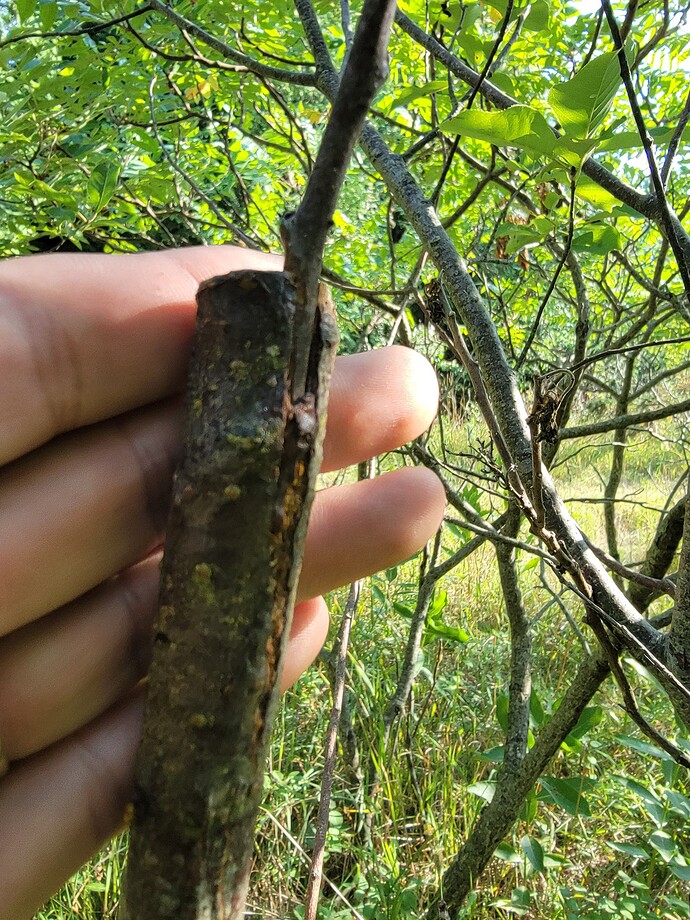
this picture that i took a month ago is too confusing.
pot 1 (which you can see) has a hawthorn rootstock variety (noid) with small red fruits that my friend brought with him from italy. last year i grafted a loquat and a pear (d’anjou, upper left in pic) onto it. i was surprised how much the scions grew. the plum scion, however, was a complete fail.
pot 2 (behind pot 1) also has the same rootstock variety, but a long time ago a different hawthorn variety (noid) with bigger fruit was grafted onto it. this is the plant in the upper right in the pic. my friend eats the fruit.
not sure if this pic i took last december will help…

it’s easier to see the leaves of the rootstock hawthorn.
when i did the grafting i kept like 50 cuttings of the rootstock. i dipped them in rooting hormone and potted them. maybe 1 or 2 took. i’m pretty sure it suckers from the roots though so guess i’ll wait for the pot to fill up with suckers and then divide them. assuming it’s a good rootstock in the long run.
i’m relatively new to grafting but i still can’t get over how much of a mad scientist it makes me feel like when there’s such a big superficial difference between the rootstock and the scions. is an angry mob with pitchforks going to come after me any second? do i enjoy feeling like a mad scientist? am i a mad scientist at heart? honestly in plenty of movies and shows i do find myself rooting for the mad scientists.
around the same time i did these grafts, i also grafted loquats onto a different friend’s indian hawthorn. they took but i don’t think that they’ve grown as much.
when two different species are graft compatible, then there’s a chance that they are also cross compatible. it’s probably a small chance. one issue with loquats is that they tend to bloom when no one else is blooming. in theory the pollen could be frozen, but that seems too involved. can we vote for somebody to do it? i nominate @a_Vivaldi.
i’d like to try grafting other species onto the little red fruit hawthorn. should i try my lost id asian pear? last year i successfully grafted it onto my evergreen pear. should i try an apple? since the plum didn’t work, does this mean it’s unlikely for anything that can be crossed with plums to work (ie cherries and apricots)?
a year ago when researching this topic, this forum came up the most, which is why i ended up joining. you folks are the most interested in the topic? do you identify as “mad scientist”?
grafting and hybridizing are high up on the list of things i wish that i started doing a long time ago. who can i blame? you? why didn’t you tell me? because you didn’t know me? so i should only blame the people who did know me? i really don’t mind blaming all my teachers. i do mind blaming my grandfather. it doesn’t seem copacetic blaming him. after all, he taught me everything he knew about gardening. unfortunately he didn’t know about grafting or hybridizing.
i want to say it’s a moot point, but now that i know about grafting and hybridizing, is someone going to blame me for not sharing this useful knowledge with them?
all gardening knowledge isn’t equally useful. ideally there should be a way for us to make it very difficult to overlook the most useful gardening knowledge. like voting?
https://www.reddit.com/r/gardening/top/?t=all
let me know how far down you have to scroll before you find a post about grafting or hybridizing. then again, perhaps i’m overestimating the usefulness of these things?
alternatively, let’s imagine if we used donations to rank forum categories. in this case perhaps i’d make the biggest donations for a grafting category and a hybridizing category. because there’s nothing worse than someone failing to realize their mad scientist potential.

